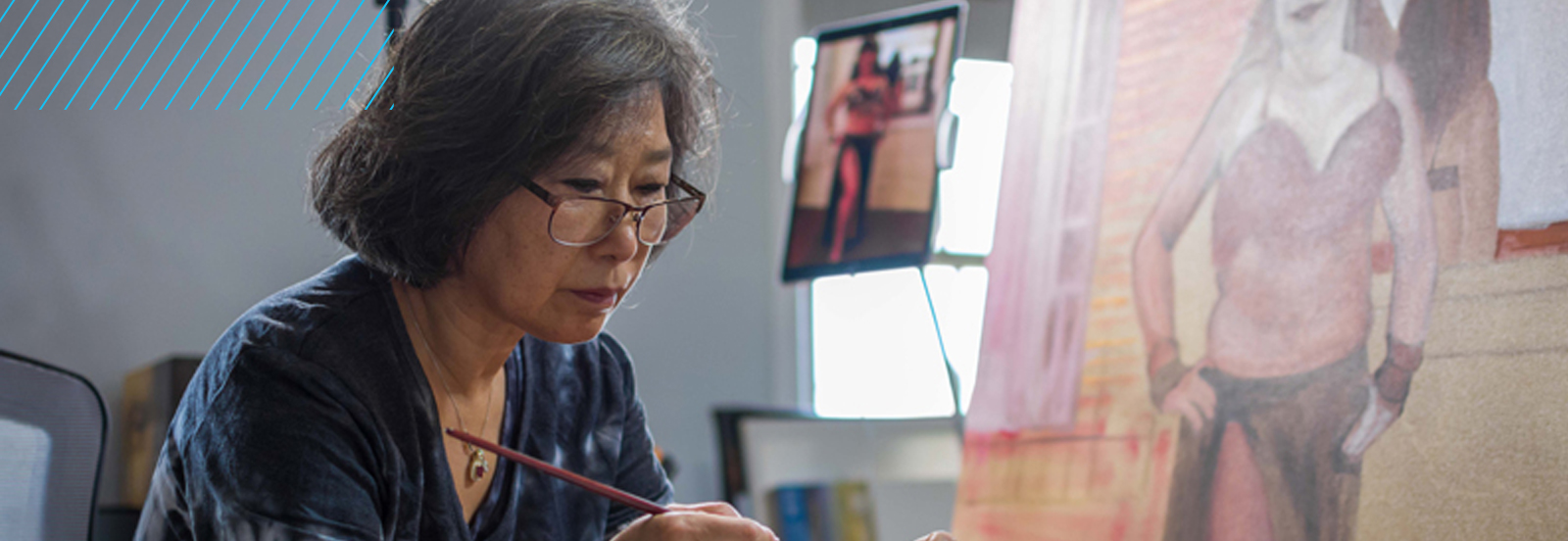Department of Art and Design
Art - Visual Arts, B.A.

Visual arts are about creating images and objects that communicate ideas, emotions, and experiences.
Overview
In the visual arts concentration, students focus on honing their artistic skills, expanding their creative expression, and developing a conceptual understanding of the visual arts. Through a combination of studio practice, art history studies, and critical analysis, students engage in a variety of disciplines and media to cultivate their artistic voice.
In studio practice, students immerse themselves in hands-on art-making, exploring various media such as drawing, painting, sculpture, ceramics, printmaking, photography, digital art, and more. They develop technical proficiency, experiment with techniques and materials, and refine their craftsmanship. Through assignments and projects, they are encouraged to explore their individual creative process, take risks, and push the boundaries of their artistic practice.
Parallel to studio practice, students delve into art history, studying the evolution of art across different time periods and cultures. They analyze significant art movements, influential artists, and critical theories that have shaped the art world. By examining historical and contemporary art, students gain insights into the socio-cultural contexts, aesthetic trends, and conceptual frameworks that inform artistic expression.
Critical analysis and visual literacy play a crucial role in the program, as students learn to articulate their artistic ideas and engage in thoughtful discourse about their own work and the work of others. They develop skills in analyzing and interpreting artworks, discussing concepts, and providing constructive feedback. This critical engagement fosters a deeper understanding of artistic intention, formal elements, and the broader cultural and social implications of art.
Collaboration and critique are integral parts of the undergraduate visual arts program. Students participate in group critiques, where they present their work and receive feedback from peers and faculty. These sessions encourage dialogue, self-reflection, and the refinement of artistic concepts and techniques. Collaborative projects and interdisciplinary approaches further broaden students' perspectives and provide opportunities for creative exchange.
Throughout the program, students are encouraged to build a portfolio that showcases their best artwork and reflects their artistic growth. The portfolio becomes a valuable tool for pursuing further education.
Curriculum and Concentration Requirements
Please review the official academic catalog for comprehensive information on requirements.
Careers
Concentrating in visual arts opens a wide range of careers in the arts and creative industries. Possible career paths for students concentrating in visual arts:
- Fine Artist: Fine artists create original works of art, such as paintings, sculptures, and installations, and exhibit their work in galleries and museums. They use their artistic skills and vision to create unique and engaging works of art.
- Illustrator: Illustrators create visual representations of ideas, concepts, and stories for books, magazines, advertisements, and other media. They use their artistic skills and knowledge of design principles to create engaging and informative images.
- Art Director: Art directors work in advertising, publishing, and other media industries to oversee the visual elements of a project, including graphics, images, and layout. They use their knowledge of design principles and project management to ensure that the final product meets the client's needs and goals.
- Museum Curator: Museum curators work in art museums, galleries, and other cultural institutions to manage and display art collections. They use their knowledge of art history and curatorial practices to create engaging and informative exhibitions and programs.
Depending on students’ interests and skills, their artistic skills and knowledge of design principles can be applied in many different ways.
